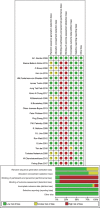The efficacy of renal replacement therapy strategies for septic-acute kidney injury: A PRISMA-compliant network meta-analysis
- PMID: 31008965
- PMCID: PMC6494389
- DOI: 10.1097/MD.0000000000015257
The efficacy of renal replacement therapy strategies for septic-acute kidney injury: A PRISMA-compliant network meta-analysis
Abstract
Background: Renal replacement therapy (RRT) is the main treatment for patients with sepsis-induced acute kidney injury (SAKI). However, the choice of RRT strategy remains controversial.
Objective: This study assessed the effectiveness of RRT variants in SAKI patients by a network meta-analysis.
Methods: This study searched the literature in the PubMed, EmBase, and Cochrane Library databases up to August 18, 2018. The outcomes of the analysis were the survival rate, renal recovery rate, intensive care unit (ICU) duration, and hospital duration.
Results: Twenty-two articles were included in the analysis. The results showed that only the negative control was inferior to the regimens of RRT with polymyxin B-immobilized fiber (PMXF), PMXF alone, continuous venovenous hemofiltration (CVVH), CVVH plus alkaline phosphatase (AP), continuous venovenous hemodialysis (CVVHD), high-volume CVVH, and extra high-volume CVVH in terms of the survival rate. According to the surface under the cumulative ranking , RRT with PMXF (84.4%) and PMXF (84.3%) were the treatments most likely to improve the survival rate among SAKI patients, followed by CVVH plus AP (69%). Continuous venovenous hemodiafiltration (CVVHDF), extra high-volume CVVHDF, intermittent venovenous hemodiafiltration (IVVHDF), and low-volume CVVHDF resulted in very similar survival rates. CVVH plus AP conferred relative advantages in the renal recovery rate and ICU duration.
Conclusion: CVVH, CVVHD, and their derived RRT strategies can improve survival rates in SAKI patients, but there is no significant difference among the RRT strategies. There was also no significant difference in the survival rate among CVVHDF, IVVHDF, and their derived strategies. More high-quality randomized controlled trials with large sample sizes are needed for further research.
Conflict of interest statement
The authors have no conflicts of interest to disclose.
Figures






Similar articles
-
Non-pharmacological interventions for preventing clotting of extracorporeal circuits during continuous renal replacement therapy.Cochrane Database Syst Rev. 2021 Sep 14;9(9):CD013330. doi: 10.1002/14651858.CD013330.pub2. Cochrane Database Syst Rev. 2021. PMID: 34519356 Free PMC article.
-
Blood Purification for Adult Patients With Severe Infection or Sepsis/Septic Shock: A Network Meta-Analysis of Randomized Controlled Trials.Crit Care Med. 2023 Dec 1;51(12):1777-1789. doi: 10.1097/CCM.0000000000005991. Epub 2023 Jul 20. Crit Care Med. 2023. PMID: 37470680 Free PMC article.
-
Systemic treatments for metastatic cutaneous melanoma.Cochrane Database Syst Rev. 2018 Feb 6;2(2):CD011123. doi: 10.1002/14651858.CD011123.pub2. Cochrane Database Syst Rev. 2018. PMID: 29405038 Free PMC article.
-
[Does continuous veno-venous hemodiafiltration therapy reduce mortality due to acute renal failure as compared to intermittent hemodialysis?].Nefrologia. 2007;27 Suppl 1:42-8. Nefrologia. 2007. PMID: 17763635 Spanish.
-
Systemic pharmacological treatments for chronic plaque psoriasis: a network meta-analysis.Cochrane Database Syst Rev. 2017 Dec 22;12(12):CD011535. doi: 10.1002/14651858.CD011535.pub2. Cochrane Database Syst Rev. 2017. Update in: Cochrane Database Syst Rev. 2020 Jan 9;1:CD011535. doi: 10.1002/14651858.CD011535.pub3. PMID: 29271481 Free PMC article. Updated.
Cited by
-
Factors Affecting Continuous Renal Replacement Therapy (CRRT) in Patients With Septic Shock: An Analysis of a National Inpatient Sample Database.Cureus. 2024 Nov 24;16(11):e74356. doi: 10.7759/cureus.74356. eCollection 2024 Nov. Cureus. 2024. PMID: 39720367 Free PMC article.
-
Optimal timing of initiating continuous renal replacement therapy in septic shock patients with acute kidney injury.Sci Rep. 2019 Aug 19;9(1):11981. doi: 10.1038/s41598-019-48418-4. Sci Rep. 2019. PMID: 31427640 Free PMC article.
-
Analysis of Leukocyte Recruitment in Continuous Veno-Venous Hemofiltration with Regional Citrate vs. Systemic Heparin Anticoagulation.Cells. 2022 Jun 1;11(11):1815. doi: 10.3390/cells11111815. Cells. 2022. PMID: 35681510 Free PMC article. Clinical Trial.
-
Surviving sepsis campaign: international guidelines for management of sepsis and septic shock 2021.Intensive Care Med. 2021 Nov;47(11):1181-1247. doi: 10.1007/s00134-021-06506-y. Epub 2021 Oct 2. Intensive Care Med. 2021. PMID: 34599691 Free PMC article. No abstract available.
-
Management of Acute Kidney Injury in Critically Ill Children.Indian J Pediatr. 2023 May;90(5):481-491. doi: 10.1007/s12098-023-04483-2. Epub 2023 Mar 2. Indian J Pediatr. 2023. PMID: 36859513 Free PMC article. Review.
References
Publication types
MeSH terms
LinkOut - more resources
Full Text Sources
Medical
Miscellaneous

